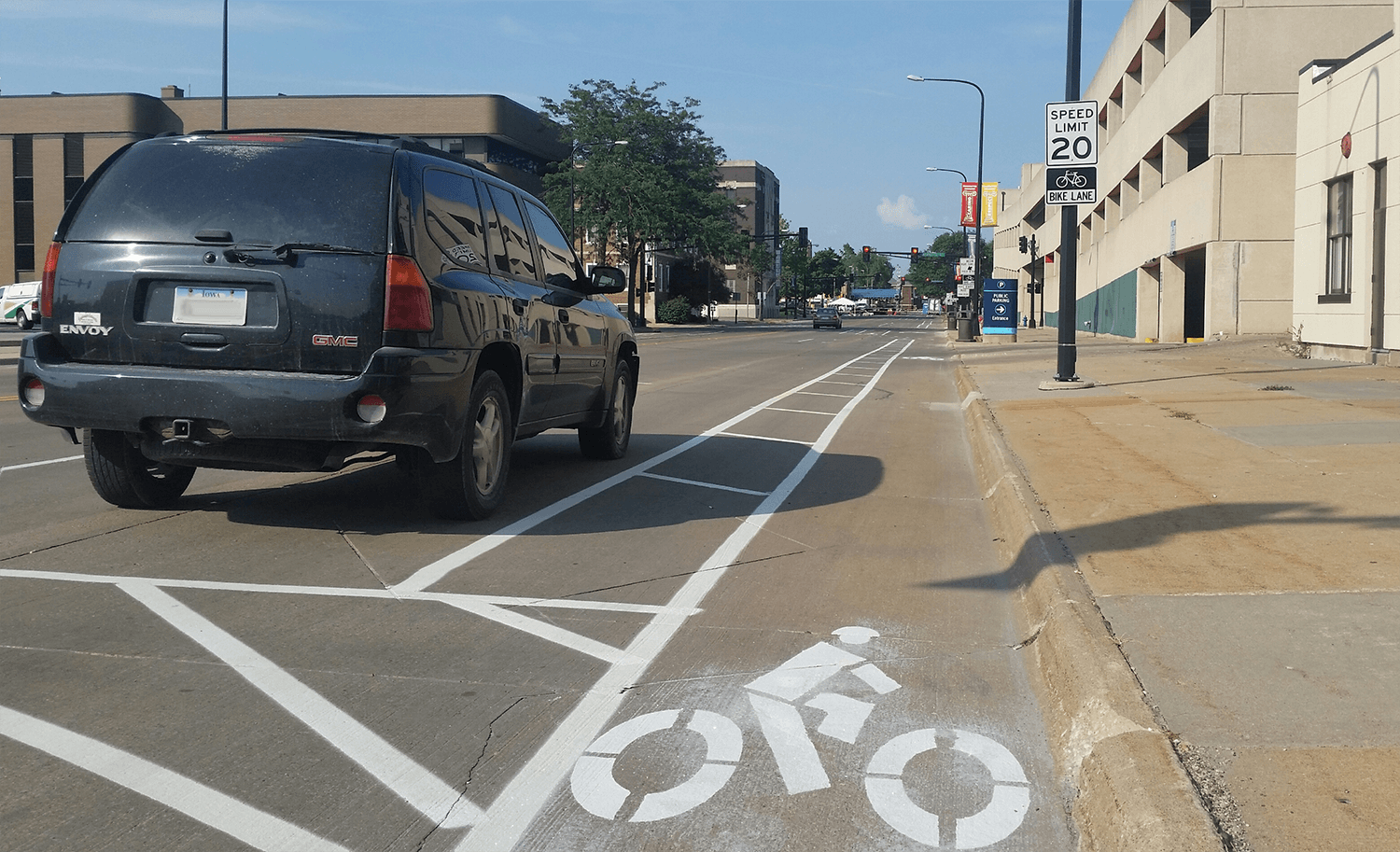Small City, Big Impact: How Waterloo, Iowa’s Cost-Effective Pedestrian and Bicycle Corridors Prove They Aren’t Just for Big Cities
July 15, 2024

Creating safe and accessible infrastructure for pedestrians and cyclists is a crucial aspect of urban planning. The City of Waterloo, Iowa, recognized the need for a dedicated way to connect its trail network, parks and event spaces. With careful transportation analysis, the city successfully transformed three-quarters of a mile of downtown Park Avenue into a pedestrian-friendly street design and bicycle-friendly corridor through a cost-effective road diet approach. The city achieved this transformation and its efforts to attract more bicyclists to the corridor through a multifaceted approach using strategic multimodal transportation planning and innovative safety measures.
The Road Diet Approach
A road diet involves reallocating road space to accommodate other modes of transportation, such as pedestrians and cyclists. Based on traffic volumes and the need for a connection between the trail systems north and south of downtown, Park Avenue was identified as the most suitable location for implementing a road diet. In the case of Park Avenue, this transformation required only pavement markings, signage and reducing the speed limit to 20 mph making it a cost-effective solution.
Implementing Bike Signals
After successfully implementing the road diet in 2017, the City of Waterloo aimed to further enhance the welfare and usability of their city by installing bicycle signals. The city enlisted the expertise of Stanley Consultants to study the corridor and develop a cycling infrastructure signal system that would provide better access for vulnerable road users.
The Engineering Study
Our Stanley Consultants’ engineering team conducted a comprehensive study of the Park Avenue corridor, analyzing its lanes, signage and signal structure. They evaluated various detection modes, including induction loops, radar detectors and video cameras, to introduce a bicycle signal queue jump. With this system, cyclists have priority to enter the intersection first. Following this, pedestrians receive a leading pedestrian interval, which lets them begin crossing before vehicles are allowed to move on a green light. Finally, vehicles receive a green light to proceed. Our engineers also recommended modifications to the bike lanes to accommodate the necessary bicycle infrastructure for implementing bike signals.
Post-Assessment Study
Following the successful implementation of the bike signals, the city and Metropolitan Planning Organization (MPO) conducted a post-assessment study. The study included feedback from users and stakeholder groups to evaluate the success of the buffered bicycle lanes. Based on the feedback, the city examined the positioning of the bike lanes, initially adjacent to the curb next to on-street parking. The report, published in 2023, proposed bicycle infrastructure alternatives that relocate the bike lanes between the travel lane and on-street parking, further enhancing safety and usability.

Lessons Learned and Next Steps
The conversion of the Park Avenue corridor was not without its challenges. The City of Waterloo encountered various issues, such as reusing underground wire circuits, parking within the bike lanes, pavement conditions, lack of education, and maintenance concerns. The city plans to address these issues with future projects.
After the road diet was implemented, there was a pause, and then the signal project was constructed. The conversion took close to six years, including closing the corridor for bridge replacement. This could have been done more efficiently by coupling projects together to reduce the duration of construction. The MPO also recognizes the need for a more robust education outreach since buffered bicycle lanes are new to Waterloo residents and other users. The city and MPO are now focusing on the next steps to expand and attract more bicyclists to dedicated systems in downtown Waterloo. The city continues to conduct traffic safety awareness campaigns and is currently running a campaign concentrating on children bicycle safety.
Waterloo's Road Diet Success
The City of Waterloo, Iowa, is an excellent example of how careful transportation analysis and cost-effective solutions can transform existing assets into pedestrian and bicycle-friendly corridors. By implementing a road diet approach and incorporating bicycle signals, they have successfully created a safer and more accessible environment for cyclists and pedestrians.
Park Avenue is an example of improving safety, public health and quality of life, which aligns with Stanley Consultants’ core values. As cities continue to prioritize active transportation, the City of Waterloo's experience can serve as a valuable guide for future projects.


